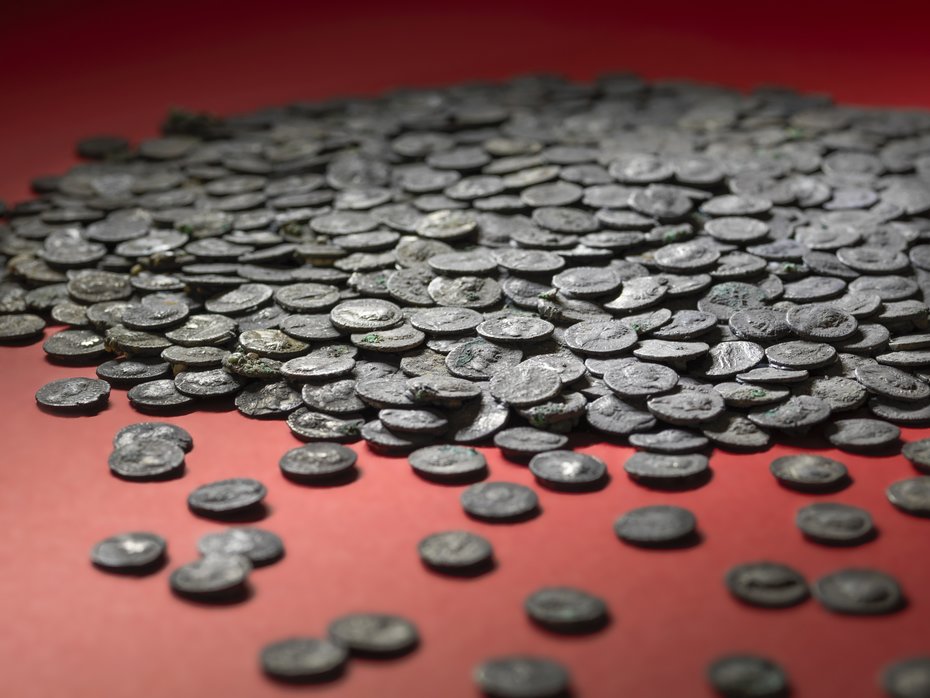2 a 3 fotka nejsou římský mince ne nebo sem blbej a slepej? Jinak paráda
The largest Roman hoard of silver coins in Bavaria
Categories: Minting - Numismatics , Treasures , Nálezy nejenom s detektorem v západní Evropě
Urban archaeologists in Augsburg, Germany, have uncovered a record-breaking Roman silver treasure. A beautifully preserved set of several thousand silver denarii from the 1st and 2nd century. century was found along with other artefacts near the city's oldest quarter, Oberhausen, on the site of a planned residential development.
The more than 5,600 coins, weighing a total of 15 kilograms, date from a relatively extended period, from the reign of Emperor Nero in the middle of the 1st century to the reign of Septimius Severus shortly after 200 AD. Coins of Traianus, Hadrian, Antoninus Pius, Marcus Aurelius and also Didius Iulianus, who reigned for only three months (March-June 193), are represented in the collection. The latter managed to mint far fewer coins and they are therefore the rarest of the set.
Augsburg was founded under the Emperor Augustus between 8 and 5 BC as a Roman military camp on the banks of the Wertach River near its confluence with the Lech River. It was the oldest Roman fortress in the Alpine foothills. Around AD 10, the temporary camp was converted into a fortress capable of holding up to 3,000 soldiers. The civilian settlement around the camp grew and took the name Augusta Vindelicorum.
During the reign of Tiberius, it became the capital of the new imperial province of Raetia. Although no legions were active there after 70 AD, the city continued to grow and prosper. At the end of the 3rd century, Emperor Diocletian reformed the imperial administration and the province was governed by a dux, the highest military authority in the region. Lower government officials still administered the day-to-day civil affairs of the province directly from Augustus Vindelicorum.
Silver coins have been discovered near the former Roman base in the gravel of the old Wertach riverbed. The present course of the river follows a straightened riverbed built in 1900. Archaeologists have explored the entire area of the future residential area: "We assume that the treasure was deposited outside the town of Augusta Vindelicum near the Via Claudia, which ran through the area in the early 3rd century. It was never recovered. The cache was probably washed away by the Wertach River during one of the floods, and the coins were scattered into the river gravel," explained Sebastian Gairhos, head of urban archaeology in Augsburg. "A simple soldier earned 375 to 500 denarii at the beginning of the 3rd century. The treasure is therefore roughly equivalent to the annual salary of fifteen soldiers," he added.
In addition to the coins, archaeologists have discovered hundreds of Roman artefacts in the remains of the original riverbed. Archaeologists sifted through more than 1,000 cubic metres of river gravel. They found weapons, tools, jewellery, utensils, over 800 coins and many other artefacts. Experts believe that all of the artifacts found are from the original military base.
Many of the finds are heavily corroded and covered in concretions from centuries spent at the bottom of the river. They will now be cleaned, conserved and subjected to closer study at the University of Tübingen. The city hopes to find a permanent home for them in a new future museum dedicated to the Roman history of Augsburg, but for now it is only "on paper". Selected coins from the hoard and some other artefacts found in the riverbed will be briefly exhibited at the Augsburg Armoury in late December this year and January next year.
Video
Roman Nemec
Sources: augsburg.de, zdf.de, zeit.de





The article is included in categories:
















